
Station Name: CIRENCESTER TOWN[Source: Peter Stephenson]
Cirencester Town Gallery 2: c1948 - c1958 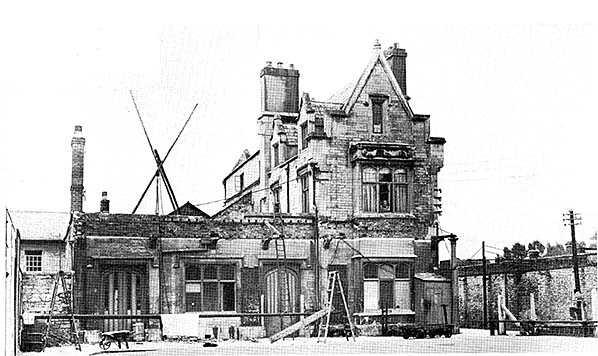 This photograph shows the poor state of the station frontage in about 1948. The front canopy itself has been removed although most of the supporting brackets are still in place. The single storey section is blocked out of use and a derrick/crane has been erected. The tall chimney to the left is part of the original single storey section but the building behind it (visible far right) is the Independent Chapel. The timber wall round the buffers has been removed (it would have been to the right of the photograph). There is now direct access from the station forecourt to the platform, round the right of the three-storey building. This photograph shows the poor state of the station frontage in about 1948. The front canopy itself has been removed although most of the supporting brackets are still in place. The single storey section is blocked out of use and a derrick/crane has been erected. The tall chimney to the left is part of the original single storey section but the building behind it (visible far right) is the Independent Chapel. The timber wall round the buffers has been removed (it would have been to the right of the photograph). There is now direct access from the station forecourt to the platform, round the right of the three-storey building.Photo from Adrian Vaughan 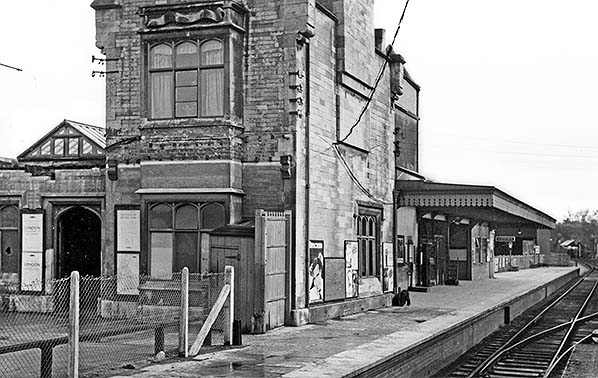
Photo showing station building after 1948 and before the 1956 rebuilding. The timber fence round the platform end and the canopy across the station front have been removed, and the frontage has been tidied.
Photo from John Mann collection 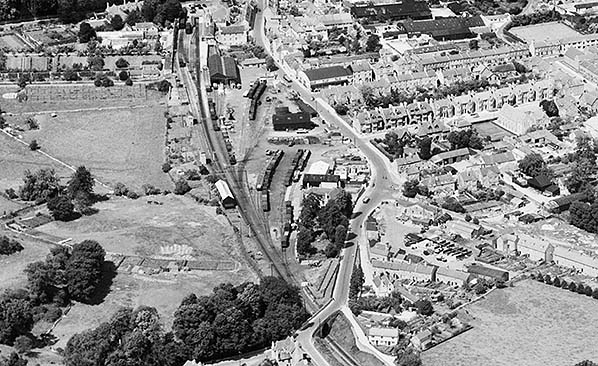 Aerial view of Cirencester Town station in 1950. View looking north, with the Querns Hill/Somerford Road bridge bottom centre and the passenger station centre top. The goods yard looks encouragingly busy. Click here to see a larger version. Photo from Britain From Above reproduced with permission 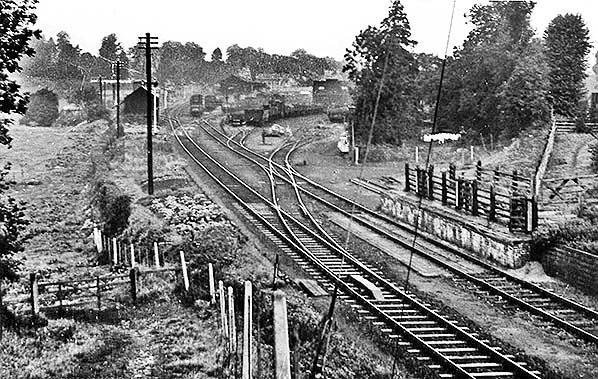 Classic view from the bridge at the station throat, showing pig dock on the right, goods yard, including both double slips and the loco shed c1950.
Photo by J. Moss 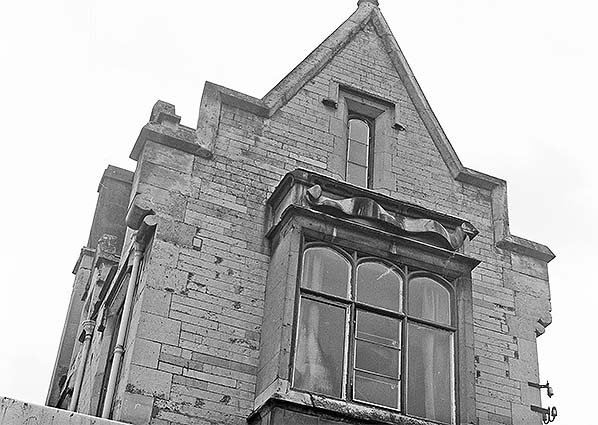
Upper part of three-storey section of station frontage, probably before the 1956 rebuild.
Photo
from John Mann collection
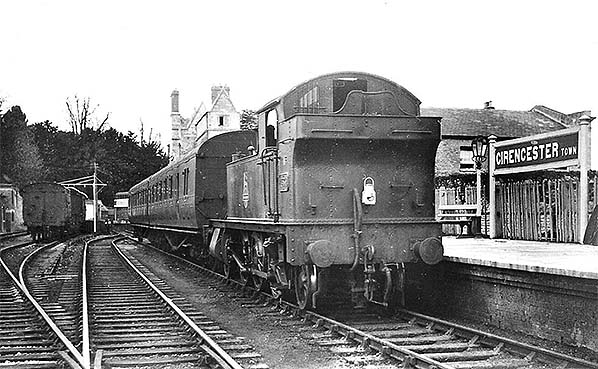
Passenger train in station, around 1950. Probably light Prairie tank with B set.
Photo from John Mann collection 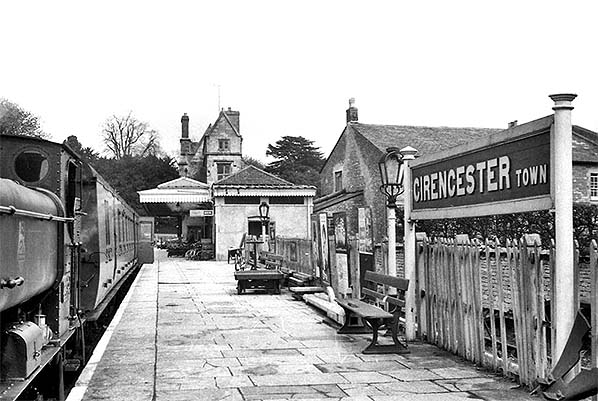 On 1 May 1956 Collett 57xx class 0-6-0PT No. 7792 awaits departure for Kemble. The train is a two-car 'B Set'; these were formed of two non-corridor brake-end vehicles of which both were, usually, Composites. The sets were coupled with the brakes at the outer ends, as seen here, and were intended for suburban and branch line use where the two brakes gave ample provision for parcels, other small sundry items, bicycles, perambulators etc. Evidence of the station modernisation, begun in 1956, can be seen. Gas lighting is still in use but replacement concrete lamp standards, for electric lighting, are lying on the platform. These probably came from the ex-GWR Taunton Concrete Works. Note the 'Gentlemen' sign in the distance, apparently and for some mysterious reason abbreviated to announce simply 'Men'. Locomotive No. 7792 was one of those 57xx class members with 'porthole' cab lookouts and squat fittings. It was a number of this type which were sold to London Transport, with whom some remained in service until 1971. No. 7792 was not among them. Built by Armstrong Whitworth in 1930 she was withdrawn in November 1957 and scrapped at Swindon Works early the following year.
Copyright photo by HC Casserley from Mike Morant collection 
Ex-GWR Collett 0-6-0PT (Pannier Tank) No. 3739 has run round its train and awaits departure back to Kemble. Despite the number, this locomotive was a member of the '5700' (or 57xx) Class, vacant blocks of numbers being allocated as batches of locomotives were built. New ex Swindon Works in 1937, No. 3739 was to survive until October 1964. The train is an ex-GWR 'B-set'. These sets could be in two or four car format, with the two car sets, intended for branch line work, being the most familiar. Often detested by passengers, the two car B-sets were typically formed Brake Third (later Second) + Brake Composite with the brake ends outermost. Both vehicles were non corridor. These sets had more than adequate space for luggage, parcels etc. and in that respect had a big advantage over the diesel railbuses which replaced them on the Cirencester branch. This photograph can be dated to the 1955/6 period. Alterations to the station are ongoing and the wall of the Gents' toilet has been rendered. On the platform gas lamps are still present but one of the concrete posts which will replace them, using electric lighting, can be seen lying on the platform. Also present are a number of the typically colourful advertisements once very familiar in a bygone age.
Photo by D Lawrence  Photograph from the 1956/7 period, this time with Churchward '4500' (or 45xx) Class 'Small Prairie' 2-6-2T No. 4566 present. The train is another two car 'B-set', these being briefly described elsewhere. Refreshing of the station is seen to be almost complete, although the now-redundant gas lamp stanchions, apparently recently repainted, are still present on the platform while beneath the canopy it would appear that not all the electric lighting has yet been installed. The ferro-concrete lamp posts are very similar to the perhaps more familiar examples produced by the Southern at its Exmouth Junction Concrete Works. The GWR/BR(W) had a concrete works at Taunton and there were subtle differences between the products of the two works, with those seen here being products of Taunton. The fence at the rear of the platform is now looking decidedly shabby while the advertisements which once adorned it have gone. Two of the three platform benches are of GWR origin while on the trolley sits a member of the locomotive crew, complete with the obligatory 'Billycan', seemingly contemplating something while eating his lunch. Locomotive No. 4566, new ex Swindon Works in 1924, was withdrawn in April 1962 and sent to Woodham's, Barry, for scrapping. This was not, however, the end as she went on to become one of three class members to survive into preservation, being extricated from Barry.
Photo from John Mann collection 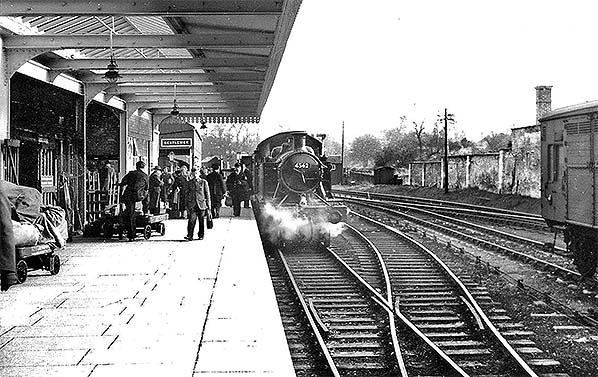
In this view the locomotive is about to run round its train with a reasonable number of people on the platform. A reasonable amount of mail and/or parcels is also present. Note the new booking office built under the far end of the platform canopy and, on the right, the horse box which appears to be a GWR Diagram N13 vehicle. Locomotive No. 4542 is an ex-GWR 'Small Prairie' 2-6-2T. Dating from the Churchward era, this locomotive was withdrawn in September 1955 so this will be the latest possible date for this photograph but as station rebuilding has begun the date will be not long prior. On the left, behind the 'Gentlemen' sign can be seen the goods shed while in the background, left of centre, can be seen the station's small engine shed and GWR water tower.
Photo from John Mann collection 
Loco running round train in view dated 13 September 1958. The station is in its form between the 1956 rebuild and the railbus era.
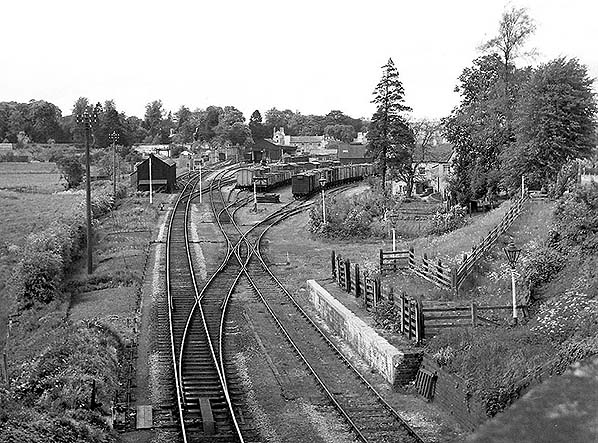 Another view from the road bridge across the station throat, this time taken c 1958. The pig dock is in the right foreground, with one of the double-slips in the centre and the enlarged goods yard to the top right.
Copyright photo from 53 Models of Hull collection
Click here for Cirencester Town Gallery 3:
|

 Home Page
Home Page